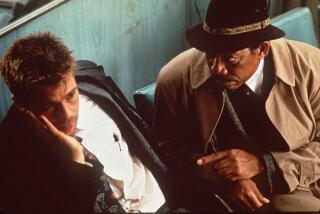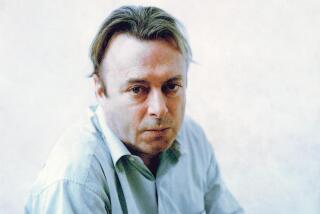Some early gems from a master
Alfred Hitchcock came to America to make the 1940 Oscar-winning best picture, “Rebecca.” Before arriving on our shores, he had long been one of England’s premiere directors, turning the film industry on its ear with his first big hit, the 1927 thriller “The Lodger.”
The revelatory new “Alfred Hitchcock: The Early Years Collection” (Lionsgate, $40) offers cineastes a rare opportunity to see five of the Master of Suspense’s early films: 1927’s “The Ring,” 1929’s “The Manxman,” (both of these silent), 1930’s “Murder!,” 1931’s “Skin Game” and “Rich and Strange.” Though these films range in quality, Hitchcock was very much the master of the medium, even during his salad days as a director. His themes also emerged early: Hitchcock’s upbringing in a staunch Roman Catholic family led him to deal with the concept of “original sin” -- his protagonists make mistakes and end up paying dearly for them.
Born in 1899, Hitchcock began his film career in 1919 by illustrating title cards for Paramount’s Famous Players-Lasky Studios in London. By 1922, he had risen to assistant director. That year, he directed an uncompleted film known as “Number 13” or “Mrs. Peabody.”
In 1925, he directed his first completed work, “The Pleasure Garden,” a British-German production shot in Berlin. While in Germany, he worked as assistant director at the UFA studio -- the hotbed of the Expressionistic style of cinema; this visual style of filmmaking influenced his entire career.
“The Ring” revolves around a lovers’ triangle. Carl Brisson, who was a former pugilist, plays a circus boxer who falls in love with and marries the circus’ pretty box office clerk (Lillian Hall-Davis). But she has her sights on a rich, successful boxer (Ian Hunter) and she leaves Brisson for Hunter.
“The Ring” was Hitchcock’s first original screenplay -- and the only film for which he was the sole writer -- and his first movie under a lucrative contract for British International Pictures.
The opening sequence of “The Ring” beautifully sets the stage for the dramatic fireworks. The studio spared no expense to design and build a working carnival for Hitchcock -- in keeping with the title the tents are ring-shaped -- and the director places his camera on the rides to give audiences a “you-are-there” insight into this world.
As he did in later films, Hitchcock gets inside the heads of the characters. At one point, Brisson witnesses Hunter and Hall-Davis flirting while he’s practicing in the gym. As Brisson punches the bag, Hitchcock superimposes Hunter’s face on the bag to reflect the fighter’s anger.
“The Manxman” was Hitchcock’s final silent film. Brisson plays a poor fisherman whose best friend is an ambitious attorney (Malcolm Keen). Brisson’s Pete proposes to the local barkeep’s daughter, Kate (Anny Ondra), but her father refuses to let them marry because Pete is penniless.
“Murder!” is an overlong but fascinating murder mystery. The film marks the first time a person’s thoughts were heard on the soundtrack of a film. And you’ll find Hitchcock making a cameo about an hour into the mystery.
Herbert Marshall plays a famous stage actor who is on the jury of a murder case involving a young actress accused of murdering another actress. Though she was found at the murder scene dazed and confused, the actress didn’t deny killing her fellow thespian in an argument; so the jury finds her guilty. But Marshall believes she really is innocent and sets out to capture the real killer using his acting expertise.
Because sound was in its infancy, the scene in which Marshall’s thoughts are heard aloud while he shaving in a mirror was filmed with a recording of the lines and an orchestra that was hidden behind the steps.
“Murder!” is quite talky, but the final sequences set during a performance of an acrobatic act at the circus are visually stunning and suspenseful.
“The Skin Game” is the weakest in the collection. Based on the 1920 hit play by John Galsworthy, the creaky drama revolves around two neighboring families living in the picturesque British countryside. The old-money Hillcrests find their bucolic existence threatened by the nouveau riche Mr. Hornblower (Edmund Gwenn), who wants to kick poor farmers off their land and buy land near the Hillcrests so he can build factories for his pottery business. The families are pitted against each other over the land, forcing the Hillcrests to revert to blackmail to stop Hornblower.
Of the film Hitchcock later stated: “I didn’t make it by choice, and there isn’t much to be said about it.”
Though panned by critics and audiences when it was first released, “Rich and Strange” is delightfully watchable. Henry Kendall and Joan Barry -- another Hitchcock proto-blond -- play a bored married couple who wish for excitement. Their wish comes true when a rich uncle offers Kendall’s Fred a windfall of money so they can travel the world. The two take a cruise around the world, but instead of strengthening their marriage, they cheat on each other. Hitchcock deftly maneuvers the film from comedy to romance to melodrama to near tragedy.
Though there are no extras with the films, the third disc includes a short documentary on Hitchcock’s early years.
More to Read
Only good movies
Get the Indie Focus newsletter, Mark Olsen's weekly guide to the world of cinema.
You may occasionally receive promotional content from the Los Angeles Times.











